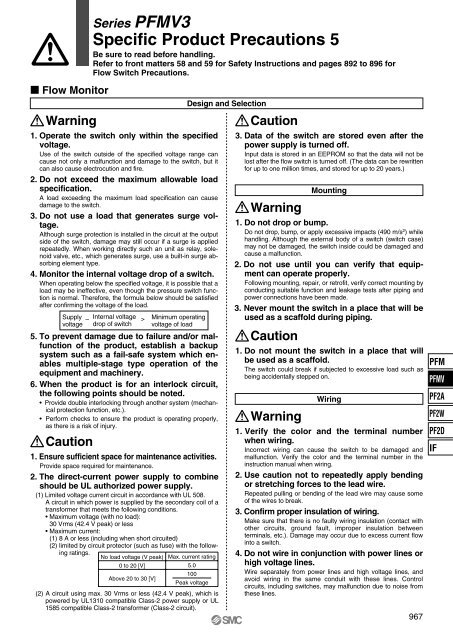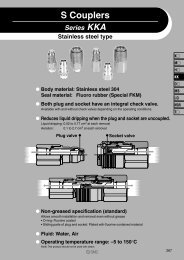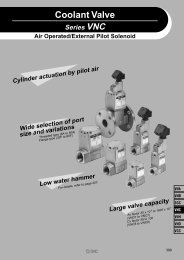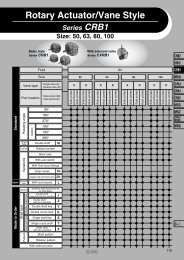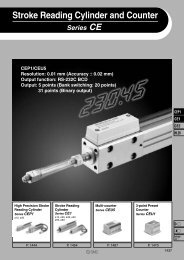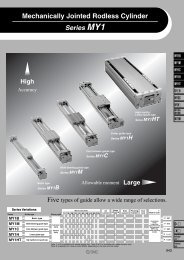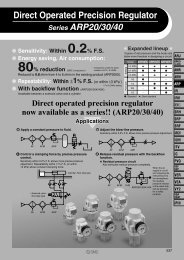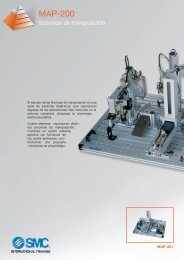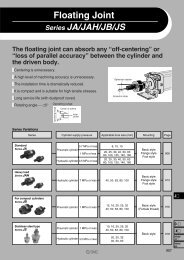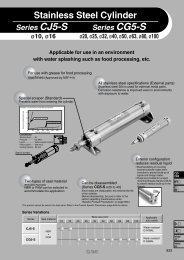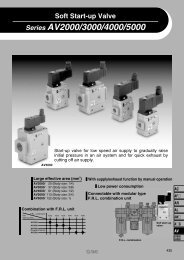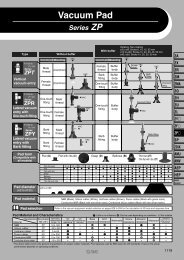You also want an ePaper? Increase the reach of your titles
YUMPU automatically turns print PDFs into web optimized ePapers that Google loves.
Flow MonitorWarning1. Operate the switch only within the specifiedvoltage.Use of the switch outside of the specified voltage range cancause not only a malfunction and damage to the switch, but itcan also cause electrocution and fire.2. Do not exceed the maximum allowable loadspecification.A load exceeding the maximum load specification can causedamage to the switch.3. Do not use a load that generates surge voltage.Although surge protection is installed in the circuit at the outputside of the switch, damage may still occur if a surge is appliedrepeatedly. When working directly such an unit as relay, solenoidvalve, etc., which generates surge, use a built-in surge absorbingelement type.4. Monitor the internal voltage drop of a switch.When operating below the specified voltage, it is possible that aload may be ineffective, even though the pressure switch functionis normal. Therefore, the formula below should be satisfiedafter confirming the voltage of the load.Supplyvoltage – Internal voltagedrop of switch>5. To prevent damage due to failure and/or malfunctionof the product, establish a backupsystem such as a fail-safe system which enablesmultiple-stage type operation of theequipment and machinery.6. When the product is for an interlock circuit,the following points should be noted.• Provide double interlocking through another system (mechanicalprotection function, etc.).• Perform checks to ensure the product is operating properly,as there is a risk of injury.CautionSeries <strong>PFMV</strong>3Specific Product Precautions 5Be sure to read before handling.Refer to front matters 58 and 59 for Safety Instructions and pages 892 to 896 forFlow Switch Precautions.Minimum operatingvoltage of load1. Ensure sufficient space for maintenance activities.Provide space required for maintenance.2. The direct-current power supply to combineshould be UL authorized power supply.(1) Limited voltage current circuit in accordance with UL 508.A circuit in which power is supplied by the secondary coil of atransformer that meets the following conditions.• Maximum voltage (with no load):30 Vrms (42.4 V peak) or less• Maximum current:(1) 8 A or less (including when short circuited)(2) limited by circuit protector (such as fuse) with the followingratings.No load voltage (V peak) Max. current rating0 to 20 [V]5.0100Above 20 to 30 [V]Peak voltage(2) A circuit using max. 30 Vrms or less (42.4 V peak), which ispowered by UL1310 compatible Class-2 power supply or UL1585 compatible Class-2 transformer (Class-2 circuit).Design and SelectionCaution3. Data of the switch are stored even after thepower supply is turned off.Input data is stored in an EEPROM so that the data will not belost after the flow switch is turned off. (The data can be rewrittenfor up to one million times, and stored for up to 20 years.)WarningMounting1. Do not drop or bump.Do not drop, bump, or apply excessive impacts (490 m/s 2 ) whilehandling. Although the external body of a switch (switch case)may not be damaged, the switch inside could be damaged andcause a malfunction.2. Do not use until you can verify that equipmentcan operate properly.Following mounting, repair, or retrofit, verify correct mounting byconducting suitable function and leakage tests after piping andpower connections have been made.3. Never mount the switch in a place that will beused as a scaffold during piping.Caution1. Do not mount the switch in a place that willbe used as a scaffold.The switch could break if subjected to excessive load such asbeing accidentally stepped on.WarningWiring1. Verify the color and the terminal numberwhen wiring.Incorrect wiring can cause the switch to be damaged andmalfunction. Verify the color and the terminal number in theinstruction manual when wiring.2. Use caution not to repeatedly apply bendingor stretching forces to the lead wire.Repeated pulling or bending of the lead wire may cause someof the wires to break.3. Confirm proper insulation of wiring.Make sure that there is no faulty wiring insulation (contact withother circuits, ground fault, improper insulation betweenterminals, etc.). Damage may occur due to excess current flowinto a switch.4. Do not wire in conjunction with power lines orhigh voltage lines.Wire separately from power lines and high voltage lines, andavoid wiring in the same conduit with these lines. Controlcircuits, including switches, may malfunction due to noise fromthese lines.967PFM<strong>PFMV</strong>PF2APF2WPF2DIF


